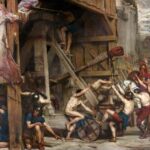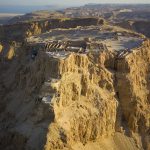The photo shows the underground part of Aqua Traiana, which transported water from an underground source located under an abandoned 13th-century church on the shores of Lake Bracciano.
Water, seeping through the volcanic ground, was collected in underground caverns and chambers, and then led through an underground aqueduct. The walls of the tunnel are covered with tiles laid in the decorative technique – opus reticulatum, i.e. arranged in the shape of rhombuses. The purpose of opus reticulatum was mainly to reinforce the concrete walls of the underground aqueduct.
Aqua Traiana transported spring water from northern Latium and southern Tuscany (then Etruria) to Janiculum (about 40 km distance). It provided drinking water for the population, and supplied baths and other public buildings.






